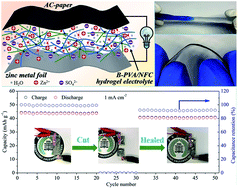High-performance flexible and self-healable quasi-solid-state zinc-ion hybrid supercapacitor based on borax-crosslinked polyvinyl alcohol/nanocellulose hydrogel electrolyte†
Abstract
With the rapid development of wearable electronics, there arises an urgent need to exploit flexible, bendable, and even self-reparative energy storage devices. In order to realize this goal, one should construct suitable gel electrolytes. Herein, a zinc-salt-containing borax-crosslinked polyvinyl alcohol/nanocellulose hydrogel electrolyte is developed, and shows great mechanical properties, intriguing self-healing feature, and high ionic conductivity. To demonstrate the feasibility of this hydrogel electrolyte, a flexible quasi-solid-state zinc-ion hybrid supercapacitor is assembled from the hydrogel electrolyte, cellulose paper cathode, and zinc metal anode. This device can combine the advantages of both zinc-ion batteries and supercapacitors. It exhibits high capacity (56.1 mA h g−1, 504.9 mF cm−2, and 224.4 μA h cm−2 at 0.5 mA cm−2), great rate capability (22.1 mA h g−1 at 10 mA cm−2), and excellent cyclability (95.3% capacity retention over 5000 cycles). It can also be folded, bent, compressed, and even self-healed while sacrificing only a small portion of its capacity. This work opens the door to new possibilities in flexible energy storage.



 Please wait while we load your content...
Please wait while we load your content...